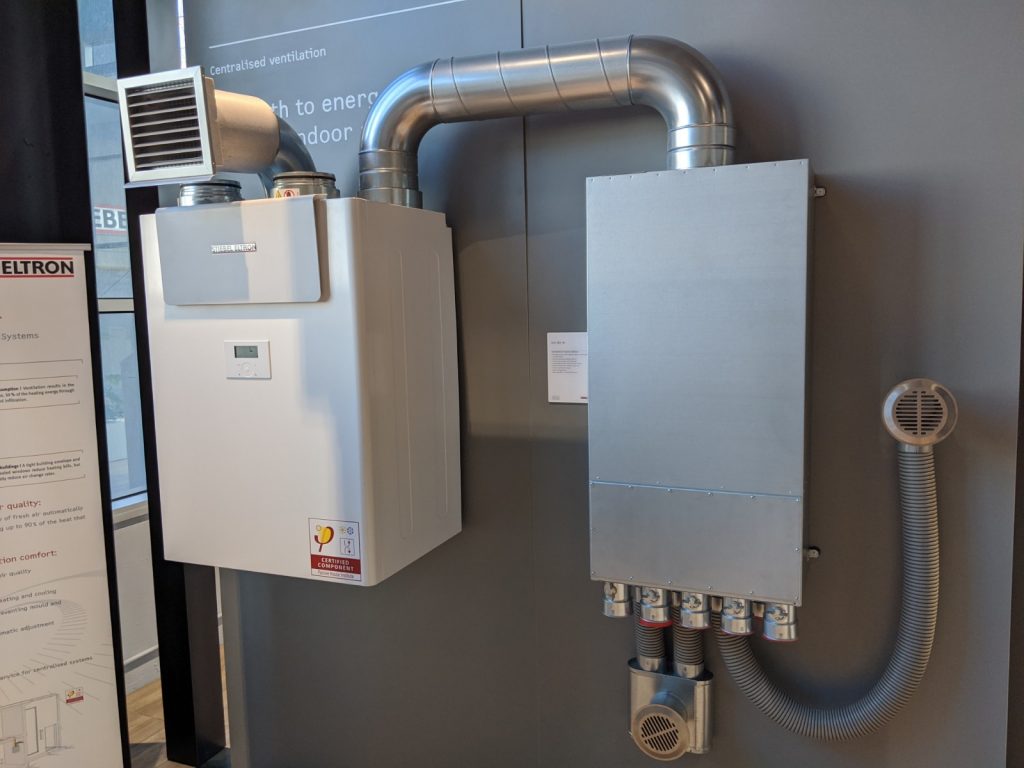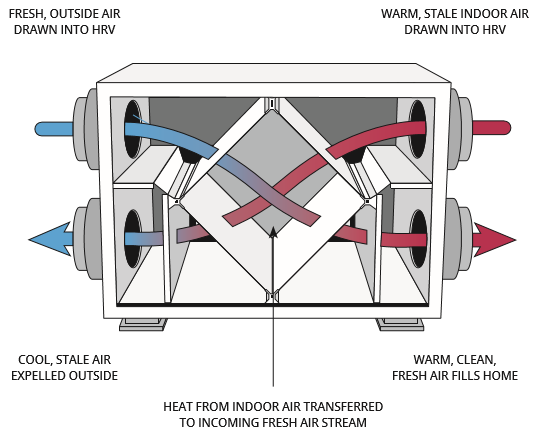Introducing the Key Perks and Uses of Heat Recovery Ventilation in Lasting Layout
Heat Recovery Ventilation (HRV) systems play a vital duty in sustainable style. They facilitate a continuous exchange of stale indoor air with fresh outside air, substantially boosting indoor air high quality. Additionally, HRVs add to energy efficiency by reclaiming warm from worn down air, which can decrease energy costs. Understanding the multifaceted benefits and applications of HRVs exposes their value in modern-day design. What various other benefits do these systems provide in the pursuit of sustainability?
Understanding Heat Recovery Ventilation Systems
Heat recovery ventilation (HRV) systems are created to improve indoor air quality while reducing energy loss. These systems use a mechanical air flow technique to exchange stale indoor air with fresh exterior air, guaranteeing a continual supply of tidy air. By catching warm from the exhaust air, HRVs precondition incoming air, reducing the need on home heating and cooling down systems. This process not just boosts thermal comfort but also contributes to power performance in household and commercial structures. Additionally, HRV systems help manage moisture degrees and decrease interior pollutants, advertising a healthier living atmosphere. Their critical implementation is necessary for accomplishing sustainable style objectives, as they use an equilibrium in between power preservation and passenger well-being.
Just How HRV Systems Work
While several may know with air flow systems, comprehending exactly how warmth healing air flow (HRV) systems run is important for appreciating their advantages. HRV systems work by exchanging stale indoor air with fresh outdoor air while transferring warmth between the two streams. This procedure takes place in a heat exchanger, where heat from the outbound air heats the inbound air throughout chillier months, reducing power loss. Conversely, in warmer months, the system can cool incoming air using the cooler outward bound air. HRVs are geared up with followers to promote air movement and filters to eliminate particulates, making certain a constant, balanced air flow procedure. This cutting-edge layout not just improves power efficiency however additionally adds to preserving a comfy interior atmosphere.
Enhancing Indoor Air Quality
Interior air top quality can significantly influence wellness and wellness, making effective ventilation essential in modern-day homes. Heat Recovery Ventilation (HRV) systems play a vital duty in preserving interior air top quality by continuously exchanging stagnant indoor air with fresh exterior air. This process not only reduces airborne toxins yet also decreases moisture levels, which can bring about mold and mildew development and respiratory system issues. HRV systems filter incoming air, getting rid of irritants and particulates, thereby supplying a healthier living atmosphere. Additionally, these systems assist eliminate smells and volatile organic substances (VOCs) commonly found in home products. By guaranteeing a constant circulation of tidy air, HRV systems add to a total improved interior atmosphere, promoting comfort and health for owners.
Energy Efficiency and Price Savings
Energy efficiency stands apart as a considerable advantage of Heat Recovery Ventilation (HRV) systems. By catching and recycling the warm from exhausted interior air, HRVs minimize the energy needed for home heating incoming fresh air, causing lowered energy usage. This effectiveness equates right into lower energy expenses, supplying significant expense financial savings for property owners and services alike. Furthermore, HRV systems often get energy performance motivations and rebates, better enhancing their economic charm. In time, the initial investment in HRV modern technology can cause a desirable return on financial investment through lowered energy expenditures. Consequently, the combination of HRV systems not just advertises sustainable design however additionally supplies a practical service for accomplishing lasting power savings and financial benefits.
Environmental Advantages of HRV

A plethora of ecological advantages emerges from the implementation of Heat Recovery Ventilation (HRV) systems. By efficiently transferring warm from exhaust air to inbound fresh air, HRVs considerably reduce the power needed for home heating and cooling down areas. This energy effectiveness translates to lower greenhouse gas emissions, adding to a decrease in the overall carbon impact of structures. Furthermore, HRV systems enhance interior air top quality by continually flowing fresh air, consequently lowering the focus of indoor pollutants and irritants. In addition, the decrease in energy consumption help in conserving natural deposits, making HRVs an essential component of sustainable layout. Overall, the ecological advantages of HRVs play a vital duty in advertising a healthier earth and cultivating eco-friendly structure practices.
Versatile Applications in Modern Style
Heat recovery ventilation (HRV) systems are progressively being incorporated right into both residential and commercial architectural projects. In household settings, HRVs boost interior air high quality while making best use of power effectiveness. In industrial rooms, these systems enhance air flow strategies, demonstrating their convenience in modern architectural applications.
Residential Projects Assimilation
While contemporary style progressively emphasizes sustainability, the combination of heat healing air flow systems in household projects has actually emerged as a functional remedy for enhancing indoor air high quality and power performance. These systems successfully transfer warm from exhaust air to inbound fresh air, decreasing power loss and reducing heating or cooling demands. In new builds and retrofits alike, heat healing ventilation can be effortlessly integrated, giving property owners with a healthier living atmosphere while reducing energy expenses. Furthermore, with increasing recognition of ecological impacts, more architects and home builders are identifying the lasting advantages of these systems. Because of this, warm recovery ventilation has actually come to be an important element of sustainable domestic design, showcasing versatility and dedication to environmentally friendly practices.
Commercial Spaces Optimization
As modern-day industrial spaces evolve to fulfill the demands of sustainability and efficiency, the execution of warm recovery ventilation systems becomes a vital method for optimizing interior atmospheres. These systems facilitate the exchange of stagnant indoor air with fresh exterior air while reclaiming warmth energy, considerably reducing power intake. This not only boosts convenience for residents yet likewise aids in reducing functional costs. Functional applications can be observed in offices, retail rooms, and universities, where air quality and temperature control are paramount. Furthermore, incorporating warm recuperation ventilation aligns with environment-friendly building qualifications, further promoting ecological responsibility. Eventually, taking on such systems in commercial style not only contributes to sustainability objectives yet also promotes much healthier, more efficient spaces for individuals.
Incorporating HRV Into Sustainable Layout Practices
Incorporating heat recovery ventilation (HRV) systems into sustainable style methods provides significant benefits in power performance and interior air high quality. By using HRV, developers can develop cost-effective solutions that not just lower power usage but also boost the overall convenience of interior settings. This positioning with sustainability goals placements HRV as an essential component in modern-day building techniques.
Energy Efficiency Improvement
By integrating heat recuperation ventilation (HRV) systems into sustainable style methods, architects and contractors can substantially improve energy performance in contemporary constructions. HRV systems operate by catching heat from outgoing stale air and transferring it to incoming fresh air, minimizing the power needed for heating or cooling down interior rooms. This process not just lowers reliance on typical a/c systems yet likewise decreases total energy usage. Additionally, HRV systems can assist preserve a consistent indoor temperature level, decreasing peak power needs. By integrating these systems, structures can attain significant reductions in energy costs and carbon footprints, straightening with sustainability goals. Eventually, HRV modern technology represents a functional solution for enhancing power efficiency in the developed atmosphere, advertising more responsible resource use.
Indoor Air Top Quality Renovation
How can warm healing air flow (HRV) systems contribute to exceptional interior air top quality in modern buildings? HRV systems successfully exchange stale interior air with fresh exterior air while recouping heat, minimizing temperature fluctuations. This procedure lowers the focus of indoor contaminants, such as unstable organic compounds (VOCs), irritants, and dampness, which can wear away air top quality and influence owner wellness. By keeping perfect humidity levels and making sure a continuous supply of clean air, HRVs aid develop a much healthier indoor atmosphere. Furthermore, these systems can be integrated right into lasting layout techniques, promoting energy efficiency along with boosted air high quality. HRV Heat Recovery Ventilation. As a result, HRV technology plays an important role beforehand total passenger comfort and well-being in modern architectural designs
Affordable Layout Solutions

Frequently Asked Questions
What Maintenance Is Required for Heat Recovery Ventilation Equipments?

Upkeep for warm healing ventilation systems usually includes normal filter substitutes, cleansing of warmth exchangers, examination of fans and ducts, and guaranteeing appropriate drain. These tasks assist maintain performance and lengthen the system's life-span with time.
Can HRV Equipments Be Mounted in Existing Structures?
Heat recovery ventilation systems can without a doubt be mounted in existing structures. HRV Heat Recovery Ventilation. Retrofitting needs mindful preparation and analysis of the building's design, guaranteeing compatibility with current systems while optimizing energy effectiveness and indoor air top quality
Just How Do HRV Solution Impact Sound Levels Indoors?
HRV systems can affect interior sound levels by introducing noise from external sources with ventilation. High-grade installations usually incorporate sound-dampening features, reducing noise impact while supplying reliable air exchange and maintaining comfort inside your home.
Exist Any Type Of Disadvantages to Making Use Of HRV Equipments?
The downsides of utilizing HRV systems include prospective high initial expenses, maintenance obstacles, and the possibility of minimized indoor air quality if filters are not HRV Heat Recovery Ventilation frequently changed, which can cause concerns with moisture degrees.
Just how Do I Pick the Right HRV System for My Demands?
Choosing the right warmth healing ventilation system includes assessing details needs, such as constructing size, environment, and power effectiveness objectives. Additionally, evaluating system attributes, installment requirements, and maintenance considerations is essential for peak performance and contentment.